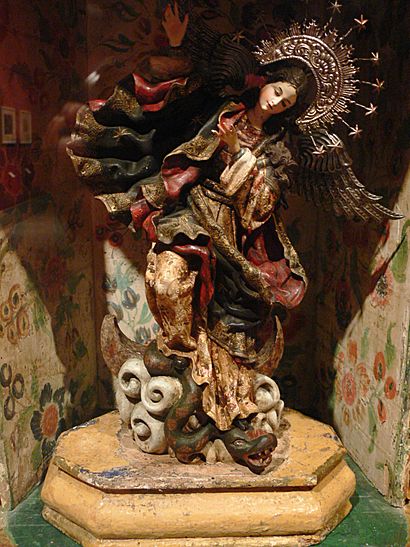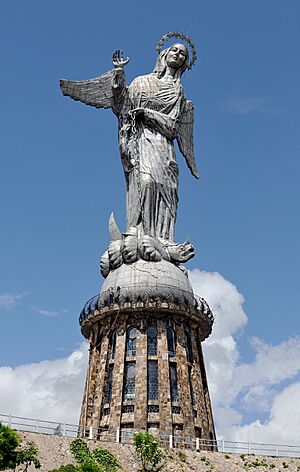Virgin of Quito facts for kids
Quick facts for kids Virgin of Quito, Virgin of the Apocalypse, Legarda's Virgin |
|
|---|---|

Virgin of Quito by Bernardo de Legarda, 18th century.
|
|
| Artist | Bernardo de Legarda (ca. 1700-1773) |
| Year | 1734 |
| Type | Wood, polychrome, silver (diadem), gold leaf |
| Movement | Quito School |
| Dimensions | 120 cm (47 in) |
| Location | Church and Convent of St. Francis, Quito, Ecuador |

The Virgin of Quito (in Spanish, La Virgen de Quito) is a famous wooden sculpture. It was made by the artist Bernardo de Legarda in the 1700s. This artwork is a great example of the Quito School of art. This art style grew in Quito, Ecuador, when Spain ruled the area.
This special statue is also known by other names. People call it the Virgin of the Apocalypse, Winged Virgin of Quito, Dancing Madonna, and Legarda's Virgin. Many copies of this Virgin are loved and honored in the northern Andes region today. The original statue was finished in 1734. It shows the Immaculate Conception and is kept in the Church and Convent of San Francisco in Quito.
What the Virgin of Quito Looks Like
The sculpture is 120 centimeters (about 4 feet) tall. Its design comes from a Bible story about the Woman of the Apocalypse. This story is found in the Revelation of Saint John (chapter 12, verses 1-2). It says the woman was "clothed in the sun."
Just like in the Bible story, the Virgin has a crescent moon under her feet. She wears a silver crown with 12 stars on her head. She has fought a dragon, which stands for Satan. The dragon has an apple in its mouth, meaning original sin. She has stepped on the dragon and holds it down with a silver chain.
The Virgin has silver wings, which help her escape. She seems to float and move, almost like she is dancing. Her hands are open and gesture to her right. Her clothes have many flowing folds, showing movement and joy. Her cloak is deep blue with silver stripes at the bottom.
Unlike European statues, this Virgin has facial features and skin color like a mestiza person. This means she looks like someone with mixed European and Indigenous heritage. The artist, Legarda, signed and dated his work.
Legarda also made a larger version of this statue. It is in the Catedral de Nuestra Señora de la Asunción in Popayán, Colombia. This bigger Virgin is called Nuestra Señora de la Asunción de Popayán. She has an even more dramatic "dancing" pose. She stands on a crescent moon and a snake. Instead of a chain, she is about to strike the snake with a lightning bolt. Both statues show parts of the Woman of the Apocalypse, the Immaculate Conception, and the Assumption.
History of the Sculpture
Legarda was already a well-known artist. In 1732, Franciscan priests asked him to create a statue of the "Virgin of the Immaculate Conception." This statue was for an altar in a side chapel of the Church of San Francisco. Legarda had to follow certain rules for this traditional image. For example, it could not include the Christ child, and the colors had to be white and blue.
He finished the statue and gave it to the Franciscans on December 7, 1734. You can see this date and his signature on the statue's hands. Everyone was so impressed by its beauty that the Franciscans moved it to the main altar. The way her hands are placed and her dress flows makes her look like she is moving. This soon earned her the nickname "Dancing Virgin." Because she has wings, people also started calling her the "Winged Virgin."
Many small copies of this famous statue exist all over Latin America. One copy, made by another famous artist named Caspicara, is in the Brooklyn Museum. The largest copy is the Virgin of El Panecillo. This huge statue is 45 meters (about 148 feet) tall. It was made by the Spanish artist Agustín de la Herrán Matorras. It stands on a hill called El Panecillo in Quito. Made of aluminum, it has watched over the city since 1976.
See also
 In Spanish: Virgen de Quito para niños
In Spanish: Virgen de Quito para niños
- Basilica and Convent of San Francisco, Quito
- List of buildings in Quito


